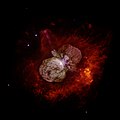Immaggine:Eta Carinae.jpg

Dimenscioìn de st'anteprìmma chi: 600 × 599 pixel. Âtre resoluçioìn: 240 × 240 pixel | 480 × 480 pixel | 769 × 768 pixel | 1 025 × 1 024 pixel | 2 015 × 2 013 pixel.
File òriginâle (2 015 × 2 013 pixel, dimensción do file: 163 KB, tîpo MIME: image/jpeg)
Cronologîa do file
Sciàcca in sce 'n grùppo dæta/ôa pe védde comm'o l'êa o file into moménto indicòu.
| Dæta/Ôa | Miniatûa | Dimenscioìn | Uténte | Coménti | |
|---|---|---|---|---|---|
| prezénte | 10:41, 18 dex 2017 |  | 2 015 × 2 013 (163 KB) | The NMI User | Reverted to version as of 14:14, 1 May 2008 (UTC) |
| 15:45, 13 màr 2017 |  | 3 000 × 2 998 (1,18 MB) | Leogorgon | larger file size | |
| 15:14, 1 màz 2008 |  | 2 015 × 2 013 (163 KB) | Vol de nuit | {{Information |Description=(NASA News Release) A huge, billowing pair of gas and dust clouds are captured in this stunning NASA Hubble Space Telescope image of the supermassive star Eta Carinae. Using a combination of image processing techniques (ditheri |
Utilìzzo do file
Nisciùnn-a pàgina a contêgne sto file chi.
Utilìzzo globâle do file
Quésto file o l'é dêuviou da 'ste âtre wiki ascì:
- Dêuviòu inte pàgine de da.wikipedia.org chi de sótta:
- Dêuviòu inte pàgine de en.wikipedia.org chi de sótta:
- Star
- Eta Carinae
- Wikipedia:Selected anniversaries/March 11
- Wikipedia:Today's featured article/March 2017
- Wikipedia:WikiProject Wikipack Africa Content/Wikipedia:Showcase
- Wikipedia:WikiProject WikiFundi Content/Eta Carinae
- Wikipedia:Today's featured article/requests/Eta Carinae
- Wikipedia:Today's featured article/March 12, 2017
- Wikipedia:Main Page history/2017 March 12
- Wikipedia:WikiProject WikiFundi Content/Wikipedia:Showcase
- Wikipedia:Main Page history/2022 March 11
- Wikipedia:Main Page history/2022 March 11b
- Wikipedia:Main Page history/2023 March 11
- Wikipedia:Main Page history/2023 March 11b
- User:2003 LN6/sandbox/Eta Carinae variable
- List of luminous blue variable stars
- Dêuviòu inte pàgine de en.wikiversity.org chi de sótta:
- User:Marshallsumter/Radiation astronomy2/Visuals
- User:Marshallsumter/Radiation astronomy2/Violets
- Stars/Astronomy
- User:Marshallsumter/Radiation astronomy2/Violets/Quiz
- Stars/Sun/Astronomy/Quiz
- User:Marshallsumter/Radiation astronomy/Courses/Principles/Hourly 2
- User:Marshallsumter/Radiation astronomy/Courses/Principles/Final quiz
- Draft:Original research/Io/Quiz
- Titan/Quiz
- Stars/Solar systems/Quiz
- Moon/Quiz
- Earth/Quiz
- User:Marshallsumter/Radiation astronomy/Colors/Quiz
- Volcanoes/Io/Quiz
- Stars/Violets
- User:Marshallsumter/Radiation astronomy2/Stars
- Stars/Violets/Quiz
- Dêuviòu inte pàgine de es.wikipedia.org chi de sótta:
- Dêuviòu inte pàgine de fr.wikipedia.org chi de sótta:
- Dêuviòu inte pàgine de hi.wikipedia.org chi de sótta:
- Dêuviòu inte pàgine de it.wikibooks.org chi de sótta:
- Dêuviòu inte pàgine de la.wikipedia.org chi de sótta:
- Dêuviòu inte pàgine de mk.wikipedia.org chi de sótta:
- Dêuviòu inte pàgine de ms.wikipedia.org chi de sótta:
- Dêuviòu inte pàgine de my.wikipedia.org chi de sótta:
- Dêuviòu inte pàgine de oc.wikipedia.org chi de sótta:
- Dêuviòu inte pàgine de ru.wikipedia.org chi de sótta:
- Dêuviòu inte pàgine de sk.wikipedia.org chi de sótta:
- Dêuviòu inte pàgine de sr.wikipedia.org chi de sótta:
- Dêuviòu inte pàgine de th.wikipedia.org chi de sótta:
Véddi l'ûzo globâle de quésto file.
